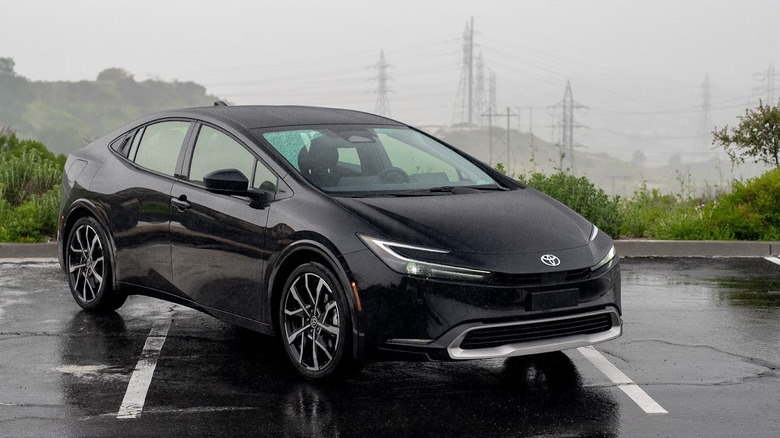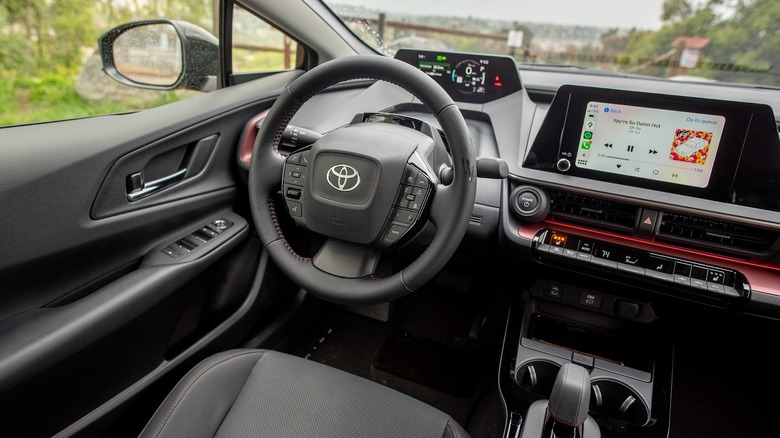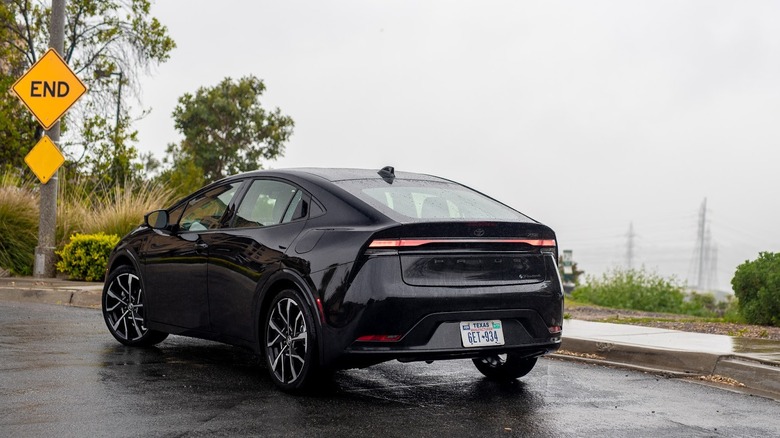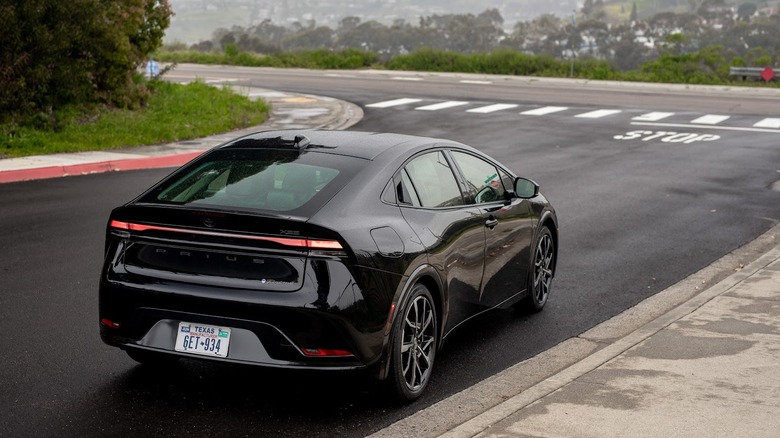2023 Toyota Prius Prime First Drive: Plugging In Is Now Cool
The clouds had finally parted, and sunshine graced the Pacific Coast Highway after a day of rain. I'd just been to the beach for a few photos, and I was silently cruising back to my hotel in EV-mode of my 2023 Toyota Prius Prime test car. I took the break in the weather as a chance to break the silence, rolled down my windows, and cued up the latest 100 Gecs album. I cranked the volume on the sound system as loud as it went, and let "Dumbest Girl Alive" echo off the cliffs of the San Diego coast. People looked at me and my Prius, and I liked it.
This is where the revolutionary nature of the new Prius Prime struck me. Yes, it is a solid car—the Prius, especially the plug-in variant, has always been a solid car—and this one is the quickest, longest-range, most-efficient Prime ever. But this fifth-generation model is also the first one where loudly head-banging to trans rave music inside it doesn't feel out of place. It feels right. Turning heads is what this car does naturally.
The Prius is cool now, and the world is a better place for it.
(Not) One Million Dollars
The style isn't all that's gotten an upgrade: the latest generation Prius Prime is a big step forward mechanically. The new hybrid drivetrain—composed of a 150 horsepower 2.0-liter four-cylinder and a 161 horsepower electric generator—puts out a combined peak 220 net horsepower, a jump of 24 HP over the standard non-plug-in hybrid version. It also delivers 139 lb-ft of torque; this all means the Prime is good for a six-point-six second zero to sixty time.
The new Prius Prime also has the longest EV-only range thus far, thanks to a 13.6 kWh battery pack, with 35% more capacity than the previous generation Prime. This gives it 44 miles of all-electric range in the base SE grade. (Higher trim XSE and XSE Premium buyers get 39 miles of pure EV driving). When used as a hybrid, the base SE achieves a stellar 53 city/51 highway MPG, and an EPA-estimated 127 MPGe for EV mode. (Higher trims, again, get a slight mileage ding, achieving a combined 48 MPG and 114 MPGe.)
All these superlatives and the Prius is still quite competitive in price; the new Prime clocks in at a base price of $32,350, making it slightly more affordable than rival plug-ins such as the Kia Niro PHEV and the old plug-in Subaru Crosstrek.
Hollywood Baby
The shockingly svelte cyberpunk styling of the fifth-generation Prius has already been one of the most-discussed topics in auto journalism this year, but it's worth reiterating that it justifies the spilled ink. The Prius has finally matured from a cluttered, frumpy utilitarian in its awkward teen years, into one of the best looking cars at its price point, hybrid or otherwise.
Where the front end of the outgoing Prius—especially of the Prius Prime—was a complicated mess, there are now a handful of carefully-drawn sharp character lines and distinctive daytime-running LEDs. The A-pillars are thin and drawn-back; the C-pillars have neatly hidden rear door handles. Together they establish a slick hatchback profile that terminates beautifully into a set of heckeblende taillights and a tautly-drawn trunk.
I wish puberty had been this kind to me.
Money Machine
The Prius has always felt a bit space-age inside; the new generation carries forward that theme with a smaller-than-average steering wheel paired with a heads-up style gauge cluster positioned over the top of it. It takes a moment to get used to, but I found it comfortable and readable. Despite the modern, minimalist feel of the cabin, drivers won't suffer with an obfuscated interface: Toyota has retained actual buttons for all important controls, as well as a volume knob on the touchscreen.
This is a welcome change from capacitive-touch-everything setups found in some competitors, and makes the Prius feel extremely user-friendly. Touchpoints are a smartly-chosen blend of smooth and textured plastics. Combined with the comfortable vegan-leather upholstered seats of the XSE trims, the interior verges on feeling downright Lexus-like.
The one exception to this premium feel is the standard 8-inch touchscreen, which looks awkward in its large piano-black bezel; the top-option 12.3-inch touchscreen unit looks much better-integrated into the interior. Regardless of touchscreen size, they're easy to operate and offer standard wireless Apple CarPlay and Android Auto smartphone projection.
Runaway
Toyota turned me loose in my blacked-out Prius Prime XSE in the rolling hills of San Diego. I began the day in EV-only mode; under 45 miles an hour, it was plenty quick for city driving. Regenerative braking was exceptionally smooth, with no step or delineation between regenerative and traditional braking. The Prime also uses its forward-facing sensory array to intelligently apply automatic regenerative deceleration upon reaching traffic, which helped with both range and ease of driving. As an in-town EV, it's delightful.
At highway speeds, it cruised well—road noise is fairly minimal despite the fuel-saving tires—but ran out of oomph around 55-60 mph; it'll do freeway pace in EV-only mode, but don't expect to make any rapid passes. For the rest of my day's drive, it made more sense to keep it in HV/EV mode, where the Prius just chose the drivetrain combination that made the most sense.
The engine is extremely low-noise and low-vibration, so switching from electric to hybrid isn't an unpleasant awakening; freeway noise stayed, essentially, the same.
The rest of the highway experience was a breeze. All trims of the Prime are bestowed with the latest suite of Toyota Safety Sensing 3.0, which has a medley of automatic assistance including pre-collision detection, lane-keep assist, and dynamic cruise control. When paired with a subscription service, this suite also allows for hands-free, under-25-mph highway driving (called Traffic Jam Assist). It's not full Level 3 autonomy—the car won't make decisions for you, and the car continually monitors the driver's eyes to make sure they stay fully on the road—but in morning commute traffic on the 5, it was a welcome benefit.
Dumbest Girl Alive
Back in the city in hybrid mode, I realized the Prime truly is fast. Somehow, I possessed a 52-MPG plug-in hatchback that could outrun an eighties turbo Supra off the line; I proceeded to get slightly silly with it, and I was rewarded for my efforts on back-country roads. There, I found out the Prius handles better than it has any right to.
Toyota slapped the battery pack under the rear seats, giving it a nice low center of gravity. The steering has no play on-center and the power assist weights nicely with more input and never feels numb. The anti-roll and suspension tuning kept the car flat, level, and predictable in corners. These factors all contribute to pleasant daily-drivability, but they also certainly helped me have more fun in a Prius than I'd ever expected.
The one major downside that stuck with me all day, whether on backroads or freeways, was visibility. The stunning, taut roofline meant that the A-pillar and B-pillar were both directly in my face; this might be less of a problem for someone shorter than 6'1", but it made seeing surrounding traffic extremely difficult for me. My blind spots were big enough that I absolutely required Toyota's blind-spot monitoring to keep me from merging into traffic. Taking a quick left turn forced me to do a little bob-and-weave around the A-pillar to check for oncoming cars.
Rearward visibility without the backup camera is also pretty poor, no matter what height you are, thanks to the steeply-raked glass of the hatch. While I still think the Prius's styling is gorgeous, there's no disputing that it makes the car harder to drive. Beauty, apparently, has a price, and it's that the eye of the beholder can't see.
The Most Wanted (Car) In the United States
The visibility was not poor enough to be a dealbreaker, mind you. I walked away still fully enamored with the Prius Prime. I tend to be a fan of plug-in hybrids in general for a variety of reasons: for one, I live in rural Idaho, and while full EVs aren't a tenable solution out there yet, plug-ins are. For another, you can build 6 Prius Primes with the battery materials required to build one Nissan Ariya, making it a more efficient use of limited precious metals, lithium, and nickel.
But more importantly, the newest Prius Prime offers all this with the same rock-solid driving experience the Prius is famed for, combined with an absolutely massive serving of style. The Prius has always been good—the plug-in arguably even more so—but it's never been this damn cool, and that makes this generation a car to celebrate. No more sheepish "yeah that's mine" moments—it's time to roll down the windows, cue up 10,000 Gecs, and proclaim your arrival.






